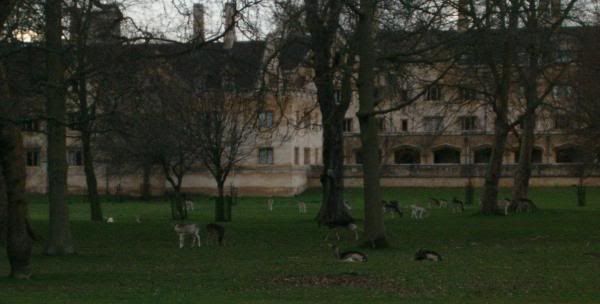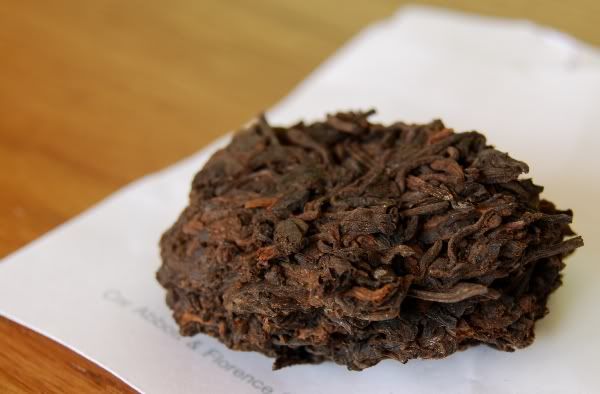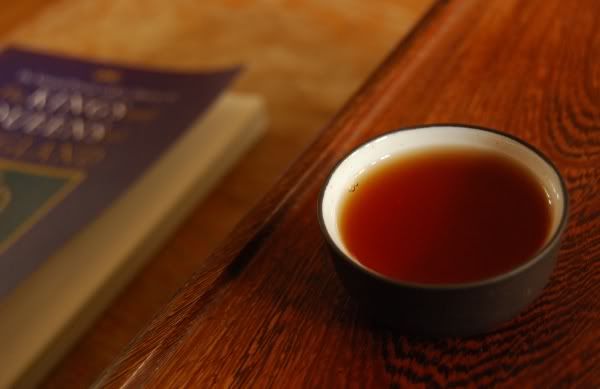Magdalen ["maud-lin"] is one of my favourite places on earth, despite the fact that the *&@#ing bell in the Great Tower cuts through sleep like a hot knife through butter.
During World War 2, the college deer (pictured below) were famously classified as "vegetables", in order to stop them being requisitioned by the Government (who were understandably trying to control meat stocks).
Lei and I have just finished running our first academic conference, in the Auditorium adjoining the deer park. You'd think it would be good experience - but I suspect it's only good experience for those hoping to go into a career in hotel management. Conference delegates are, apparently, very needy people. "I need this! I need that!" Phew...
2.5 hard days later, and we need some recovery treatment. We open the remainder of a sample sent generously by Warwickb. What better way to restore that which has been worn thin?
Tongxinghao is an interesting one - it is an "ancient" brand, dating back to before the Cultural Revolution. There is a more modern imposter, trading on the Tongxinghao name. This tea, from the later end of the 1970s, falls between the old Tongxinghao and the new. I can only assume that the brand survived (?) the Cultural Revolution - but if you have any further information, it would be most gratefully received.
Warwickb noted that the leaves were grown on Yiwu, but we regularly read the caution that Yiwu leaves were not well-known prior to more modern cakes. So, who knows!
No matter the brand history, the leaves themselves are believably 1970s - they have the orange rustiness of advanced age, and they have a light dusting of "golden flowers". You might be able to make out some of these little yellow specks in the above photograph (as ever, a click will enlarge it in a new window).
Warwickb noted that the leaves were grown on Yiwu, but we regularly read the caution that Yiwu leaves were not well-known prior to more modern cakes. So, who knows!
No matter the brand history, the leaves themselves are believably 1970s - they have the orange rustiness of advanced age, and they have a light dusting of "golden flowers". You might be able to make out some of these little yellow specks in the above photograph (as ever, a click will enlarge it in a new window).
The blend is mostly made from small fragments of small leaves, and it has a thick, woody aroma. A fine dust settles in the chahe [char-her = tea lotus, the dry-leaf holder], but otherwise it is very clean. The leaves are surprisingly thick and strong - this was a very healthy tea.
To drink this tea is to unwind entirely. While old and woody, it has a sweetness of such magnitude that I am startled. It hangs for whole minutes in the mouth and throat.
The first cup (i.e., first three sips) pushed goosepimples onto the skin of my arms; the second cup (i.e., sips 4 through 6) leave my eyes wide open and alert. Curious physiology! My heart rate has noticeably slowed, and a feeling of deep calm descends.
To drink this tea is to unwind entirely. While old and woody, it has a sweetness of such magnitude that I am startled. It hangs for whole minutes in the mouth and throat.
The first cup (i.e., first three sips) pushed goosepimples onto the skin of my arms; the second cup (i.e., sips 4 through 6) leave my eyes wide open and alert. Curious physiology! My heart rate has noticeably slowed, and a feeling of deep calm descends.
Sometimes when I leave old pu'er out overnight (in the pot), it becomes sweet and vanilla-like the next day. The sweetness of this Tongxinghao, however, is vanilla-like by the end of the second infusion. The tetsubin emphasises its smooth, creamy nature.
Very many thanks, Warwickb, for your exceptional generosity. I don't know how much you paid for this delicious cake, but I'm sure it's worth it!
Very many thanks, Warwickb, for your exceptional generosity. I don't know how much you paid for this delicious cake, but I'm sure it's worth it!






Incredible! I'd of course love to try this Puer or one quite like it. I've never had a startlingly sweet Puer. And I'd like to have the experience of profound calm sweep over me instead of the kick Puer has given me in the past. It has fired me up in ways that are stronger than coffee has ever affected my body but I haven't yet experienced a greater calm from the Puer.
ReplyDeleteDear Jason,
ReplyDeleteThere're quite a few on-line vendors that sell samples of aged teas - spending $10 on two sessions is more appealing to my limited means than spending $600 on a cake, for example. :)
Toodlepip,
Hobbes
I also had the privilige to taste
ReplyDeletethis wonderful tea...it really has been an amazing experience with everlasting infusions !!
Dear Hobbes,
ReplyDeleteCan you point to or provide more info on the "golden flowers" you mention? These are new to my beginner's mind.
Thank you kind sir!
We don't actually eat the deer these days though, bless them...
ReplyDeleteDear Kim,
ReplyDeleteSo true, it lasts forever.
Dear Anonymous,
The so-called "golden flowers" are the little yellow specks that you might be able to see in the top image (click on it to enlarge it in a new window). CB once had such specks magnified at a friend's lab, and they turned out to be crystalline structures.
Dear Luca,
When the Magdalen buttery serves steaks for £1, there's no need to head into the Grove... :)
Toodlepip,
Hobbes
Do we Know of what substance(s) said structures are made? Shall we wish to learn? I posit they are pure essence.
ReplyDelete~ohm~
Hobbes,
ReplyDeleteI also had the privilege to engage with this tea. I shared some with a friend and we were both somewhat blown away.
So smooth, rich, woody and sweet. I can only hope us modern enthusiasts can cultivate our own aged shengpu.